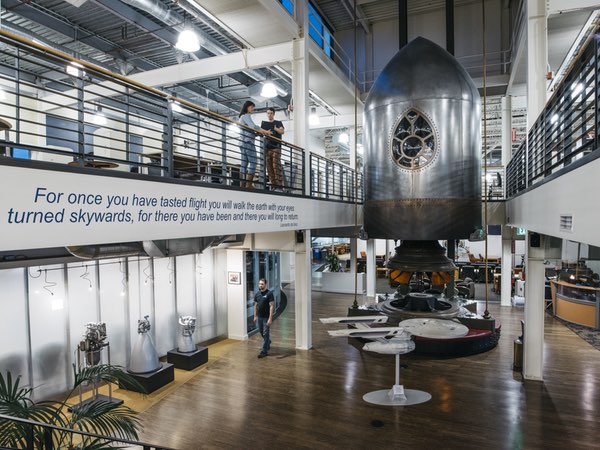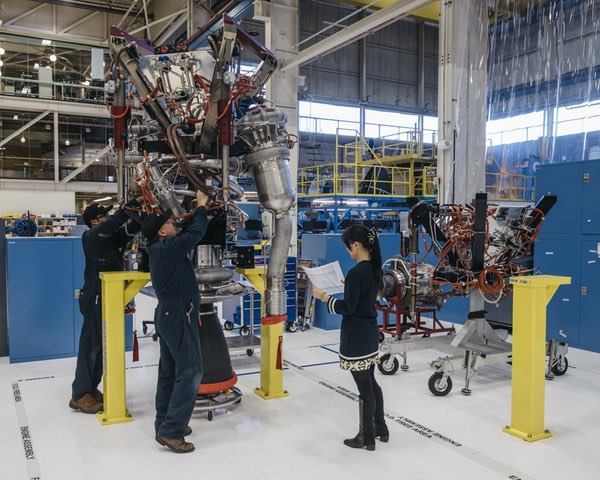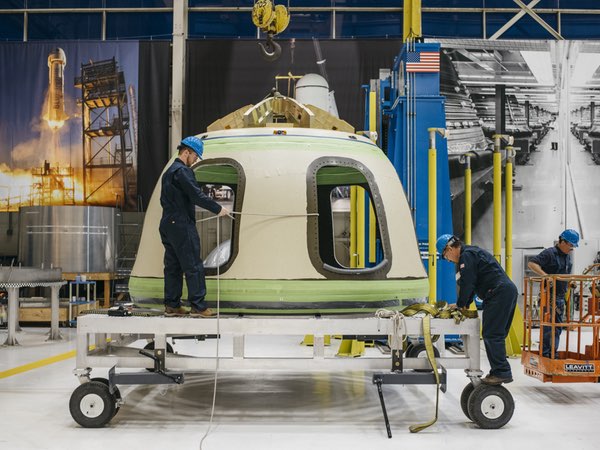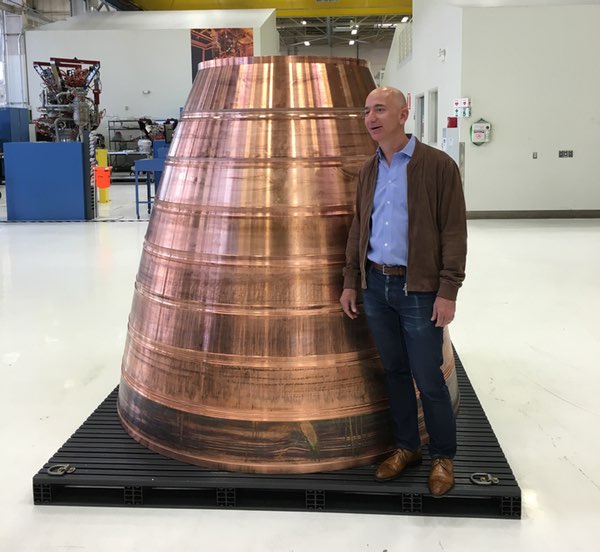
A look inside Blue Originby Jeff Foust
|
| “I’ve always said space is really easy to overhype,” said Bezos. |
The mystery of the company’s identity is resolved once you walk inside the front door, with a simple sign. But it’s only when you walk up a flight of stairs to the main lobby is it clear that this place is unique. That lobby is dominated by a giant model of the projectile-shaped spacecraft from Jules Verne’s From the Earth to the Moon (with, as it turns out, a cabin accessible from an upper floor with Victorian-era furnishings.) The rest of the lobby is filled with collectibles from both spaceflight and science fiction: a Russian Sokol spacesuit and Apollo training suit sit alongside a model of Spacedock from the Star Trek movies and a door from the Battlestar Galactica TV series. It’s as if you wandered into a hidden space museum.
Welcome to Blue Origin.
Earlier this month, the company, known for years for its secrecy, opened its doors to a handful of reporters for the first time. The purpose was not to show off the company’s collection of space and sci-fi artifacts—though that was a nice bonus—but instead to demonstrate its capabilities as the company’s suborbital and orbital programs gain momentum.
“I’ve always said space is really easy to overhype,” said company founder Jeff Bezos, who participated in the tour. “I’ve always said the same thing, which is we’ll talk about Blue when we have something to talk about.”
 A view of the lobby at Blue Origin’s headquarters. (credit: Blue Origin) |
Blue Origin, it seems, now has plenty to talk about. For more than two hours Bezos and company executives led reporters on a tour of the nearly 28,000-square-meter building, with a focus on the factory floor. With recording prohibited and photography limited to a single opportunity of a BE-4 engine nozzle near the end of the tour, reporters were left furiously scribbling in their notebooks as they toured the building.
In one part of the building, workers were assembling several of the company’s New Shepard suborbital vehicles. Two crew capsules, with openings for what Blue Origin says will be the largest windows of any space vehicle, were under construction, along with three propulsion modules. The company plans to build six vehicles—counting the one lost in an April 2015 test flight—then let the market determine how large the fleet should be.
That market will be based on both space tourism and research. The vehicle is designed to carry six people, with no pilot: the vehicle will fly autonomously, with no need for a pilot on board. The first flights with people on board could take place next year, but would involve test pilots, not paying passengers.
| “We’ve got a lot of confidence in our schedule,” said company president Meyerson of BE-4 development. |
But wait: if the vehicle flies autonomously, one reporter asked, what does a test pilot do? Bezos offered one of his characteristic laughs that punctuated the tour. Perhaps, he suggested, it would be better to call them “test passengers,” since they will not control the vehicle but instead report on its flight characteristics.
The tour also showed off the BE-3 engine that powers New Shepard. That engine, which uses liquid oxygen and liquid hydrogen propellants, is being upgraded, and Blue Origin works on an upper-stage variant, known as the BE-3U, with an expanded nozzle. The BE-3U work is being done under a contract with Orbital ATK, which is considering the engine for a proposed new launch vehicle it has received Air Force funding to study.
 Engineers assemble a BE-3 engine. (credit: Blue Origin) |
However, a greater emphasis of the tour was the company’s work on the BE-4 engine, the more powerful engine that uses liquefied natural gas (LNG) and liquid oxygen propellants. Blue Origin had been developing that engine internally for some time when it entered discussions with United Launch Alliance, which was looking for an engine for its proposed Vulcan launch vehicle.
Those discussions led to some changes in the BE-4 design. Blue Origin originally planned the BE-4 engine to produce about 1,780 kilonewtons (400,000 pounds-force) of thrust, but ULA’s requirements drove a redesign to increase its thrust to 2,450 kilonewtons (550,000 pounds-force). The engine still uses readily available LNG, which Blue Origin engineers explained is far less expensive than the specially refined kerosene known as RP-1 used by engines like the RD-180 and SpaceX’s Merlin.
On the factory floor, Blue Origin set up several stations where engineers discussed their work on various elements of the BE-4 design, from an overview of the engine down to specific details like the design of injectors. The story they told was that work on the BE-4 engine was on track, with the first test firings of the full engine scheduled for late this year. “We’ve got a lot of confidence in our schedule,” said company president Rob Meyerson.
That emphasis was understandable, since BE-4 is competition with Aerojet Rocketdyne’s AR1 engine to power Vulcan. Or not: in the eyes of Blue Origin, ULA has already made their choice with the BE-4, and is keeping AR1 as a backup, even though ULA has made no formal selection of either vehicle.
“BE-4 is for Vulcan, and AR1 is the backup,” Bezos said. “If they [ULA] have to go with AR1, there will be a significant delay.”
| “I wanted to start a space company from when I was a little kid,” Bezos said. “But I never expected to have the resources to do so.” |
Assuming that ULA does stick with the BE-4, and Blue Origin’s own orbital launch vehicle development progresses (the company announced plans last year to build the vehicle in a new factory it will construct at Cape Canaveral), the company is making plans to move from BE-4 development to production. Bezos and other officials showed off the sophisticated manufacturing equipment the company has on site, including five-axis milling machines, laser welders, and 3-D printers.
The company’s plans call for an assembly line dubbed the “BE-4 highway” that will be used for initial production of the engine. That highway will culminate in a two-story stand to accommodate final vertical assembly of the engine, some six meters tall. That highway will be able to accommodate “low-rate” production of about 12 engines a year. Eventually, as demand for the engine grows from ULA and Blue’s own vehicle, the company plans to build a separate, dedicated engine production facility.
 A New Shepard crew capsule being transported across the factory floor during the assembly process. (credit: Blue Origin) |
Blue Origin is still a secondary venture for Bezos, the CEO of retailing giant Amazon.com. He said he spends most Wednesdays at Blue Origin. However, it was clear from the tour that even with that limited time, he is still heavily engaged in the company. Throughout the tour, Bezos chimed in, his enthusiasm matched by his technical expertise, diving into details about engine design that showed a significant level of expertise when it came to rocket science.
Bezos noted in a later conversation with reporters that he long had an interest in spaceflight, and that the wealth he’s earned from Amazon is enabling him to carry out that vision. “I wanted to start a space company from when I was a little kid,” he said. “But I never expected to have the resources to do so.”
“I won a lottery ticket called Amazon.com,” he continued. “I realized, ‘Hey, I can actually fulfill my childhood dream of starting a space company.’ And that’s what I did.” Bezos didn’t say how much of that “lottery ticket” he’s invested in Blue Origin, but suggested it was more than $500 million. “Let’s just say it’s a lot,” he said.
That childhood dream has now grown into a major venture. Blue Origin has about 600 employees today, he said, with plans to grow to about 1,000 over the next year, a total he said increases to 1,200 when counting its Florida facilities. “A lot of the people we’re hiring are for BE-4 and for [the] orbital [launch vehicle],” he said.
That’s putting some strain on the company’s headquarters: remodeling will create room for some new employees, but Bezos said the company is leasing office space at another building a few blocks away for engineers.
Those engineers are feeding a growing “pipeline” of engines and vehicles. Bezos said he anticipates New Shepard entering commercial service in 2018, and the company’s own orbital launch vehicle ready by the end of the decade. That will be in addition to the BE-4 engine deliveries Blue Origin plans to make for ULA’s Vulcan.
As at last September’s event in Florida to announce plans to build the vehicle there (see “Blue goes to Florida”, The Space Review, September 21, 2015), Bezos declined to go into details about the capabilities of that new launch vehicle. That raises the question whether it might compete with ULA’s Vulcan or Orbital ATK’s proposed vehicle that could use Blue’s BE-3U upper stage engine.
| “And then, some time in the next few hundred years, there will be a big inversion, where we will realize we shouldn’t be doing heavy industry on Earth.” |
Bezos said that Blue Origin will disclose more details about its orbital vehicle, nicknamed the “Very Big Brother,” later this year, hinting that it will be the smallest of a planned family of orbital vehicles. He suggested, though, he was not particularly interested in pursuing national security launches, which form the bulk of ULA’s business today.
“That is ULA’s specialty,” he said. “I am very excited about supporting them in that effort. That is a very specialized class of business.”
“There may be things that are very specialized in how those payloads are treated and how the vehicles are certified,” he continued. “It may be very logical for ULA to continue to be the specialized in doing that and we just support them with the engines.”
He didn’t mind competing with SpaceX, although he played down any kind of personal rivalry with its founder, Elon Musk. “Space is really big, and there’s room for lots of winners,” he said. “It’s very rare to see new industries built by single companies.”
“We’ve talked to each other many times,” Bezos said of Musk. “I think we’re very like-minded about a lot of things. We’re not twins in terms of our conceptualization of the future or how space will be developed, but there’s a lot of similarities.”
 Jeff Bezos poses with a BE-4 copper nozzle liner during a March 7 tour of the company’s facilities. (credit: J. Foust) |
While Musk frequently talks about establishing a human presence of Mars to make humanity a “multiplanetary species,” Bezos has a more general vision of millions of people living and working in space, one that he acknowledges may take centuries to enable.
That vision involves what he calls a “great inversion” that will gradually move manufacturing off Earth. “Space is chock full of resources,” he said. “Right now, we use heavy industry on Earth to send ‘vitamins’ in space.” The “vitamins” he referred to in his analogy were microprocessors, but he said it applied to almost anything .
Over time, he foresees industry making simple things in space, using basic resources like regolith and volatiles. “And then, some time in the next few hundred years, there will be a big inversion, where we will realize we shouldn’t be doing heavy industry on Earth” to avoid pollution and because of a lack of terrestrial energy resources. “What will happen is, we’ll make all of the vitamins in space and we’ll just send the vitamins down to Earth. We’ll make the microprocessors in space.”
That sounds like the vision of a dyed-in-the-wool space advocate dating back to the era of Gerard K. O’Neill and space colonies. And, he seems to prefer in-space settlements to those on, say, the surface of Mars. “A lot of people will live in space because, first of all, it will be pleasant by then,” he said. “You’ll have very nice space stations and so on.”
“All the people who think they want to live on Mars, they should first spend a few years living in Antarctica, because Antarctica is a garden paradise compared to living on Mars,” he said. “Living on Mars is going to be for the very hardy, the very adventurous people who don’t like trees, parties, restaurants, movies.”
“Well, maybe they’ll get some movies,” he added. “We’ll send them Amazon Prime subscriptions.”
Bezos admitted that is a very long term view: “I’ll be dead before I’m proved wrong,” he joked. However, the progress Blue Origin has made over the last 15 years is pretty much on track with his expectations. “I’d say we’re right about exactly where I would have predicted to be,” he said.
| “It took a long time to get the pipeline filled, and now really exciting, cool stuff, not just hype, is coming out the other end. It’s exciting to talk about it. We want the world to know.” |
Bezos said he sees the company transitioning from primarily research and development to production and operations, both with New Shepard and its orbital ambitions, “Now we’re at the part of the business that I like the most, which is to get really good at it,” he said. “Now you’re at the really fun part, where you get to make lots of incremental improvements in operations and particular subsystems and so on, and get really good at it.”
And, as the company makes more of those improvements and advancements, and more things emerge from that developmental pipeline, Bezos promised more glimpses into the inner workings of Blue Origin, including tours of the company’s West Texas test site and Florida manufacturing and launch facility. “This won’t be the last time we invite you guys to come see stuff,” he said.
“In this business there’s a lot of price of admission,” he said. “If it’s six years to build an engine, you can talk about it in year one, but it’s probably better to wait until year four. We could talk about what we’re going to do with our tourism missions, and we could do a bunch of things to do that, and we could have started that ten years ago. But, I don’t think it would have actually helped us, and I think it might have even distracted us.”
“The big change is that stuff is coming out of this big long pipeline,” he said of the company’s new openness. “It took a long time to get the pipeline filled, and now really exciting, cool stuff, not just hype, is coming out the other end. It’s exciting to talk about it. We want the world to know.”